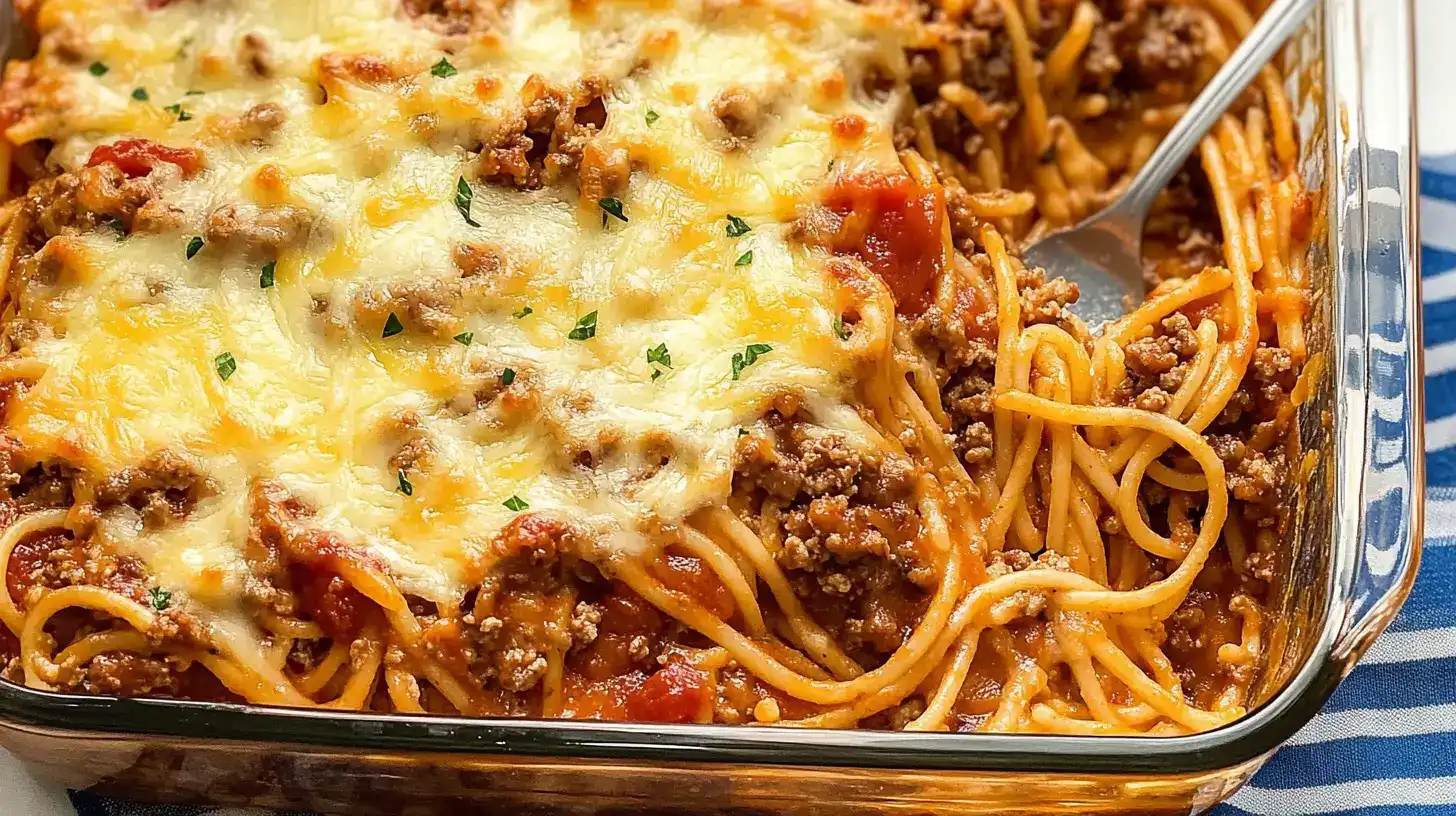What Makes a Spaghetti Casserole Recipe So Special?
Spaghetti casseroles combine classic Italian-American flavors with a cozy, one-pan appeal. Spaghetti casserole recipe dishes bring together tender pasta, creamy sauce, and melted cheese in a way that feels both nostalgic and fresh. Basically, this dish offers a versatile canvas for cooks to personalize their own hearty meal. Indeed, it’s a pleasing alternative to traditional spaghetti dinners. Consequently, it allows for endless flavor variations. Moreover, it’s easy to assemble, making it perfect for both beginners and seasoned home cooks.
Additionally, a spaghetti casserole recipe works well for casual weeknight dinners, family potlucks, or even special gatherings. Undoubtedly, the simplicity of layering noodles, sauce, cheese, and savory fillings makes it appealing. Comparatively, it is less fussy than assembling lasagna. Altogether, this baked pasta dish is more than just convenience. Eventually, the flavors deepen as it bakes, creating a delightful, comforting meal that’s easy to love.
Choosing the Right Pasta for This Spaghetti Casserole Recipe
While spaghetti is the star, you have flexibility in choosing your pasta. Traditionally, regular spaghetti noodles offer the best texture and uniformity. However, you can also try whole-wheat spaghetti or gluten-free alternatives. Basically, ensure the pasta you choose holds up well during baking. Thus, a slightly undercooked noodle will finish cooking in the oven and absorb the flavors from your sauce. Moreover, avoid thin angel hair pasta, as it tends to overcook. Conversely, thicker spaghetti strands provide a pleasant bite.
Essential Sauces and Seasonings in a Spaghetti Casserole Recipe
When selecting a sauce, you have many options. Initially, a good-quality store-bought marinara offers a simple start. Nonetheless, a homemade tomato sauce can bring more depth. Additionally, consider using meat sauce, or even a mixture of tomato and Alfredo sauces for a creamier texture. Particularly, seasoning is important. Equally, adding fresh herbs like basil or oregano enhances flavors. Furthermore, sprinkling in red pepper flakes provides a mild heat. Eventually, blending sauces and spices allows you to create a signature taste that’s memorable and delicious.
Perfecting the Texture in Your Spaghetti Casserole Recipe
Texture plays a key role in the final outcome. Generally, you want the pasta to be tender but not mushy. Therefore, boil it until it’s slightly underdone, since it will continue cooking as it bakes. Another factor is the cheese you choose. While mozzarella melts smoothly, adding a layer of shredded cheddar or provolone brings complexity. Hence, mixing ricotta or sour cream creates a rich, creamy layer that contrasts with the tomato sauce. Comparatively, fresh herbs on top add a bright finish. Finally, baking uncovered at the end helps brown the cheese, adding an appealing crispy crust.
Classic Ingredients for Your Spaghetti Casserole Recipe
A classic spaghetti casserole recipe often includes pantry staples and readily available ingredients. Chiefly, you’ll need spaghetti noodles, a quality tomato sauce, and shredded mozzarella cheese. Additionally, consider incorporating ground beef or Italian sausage for a savory depth. Afterward, mix in onions, garlic, and bell peppers for sweetness and aroma. Particularly, sour cream or ricotta adds creaminess between the pasta layers. Also, a generous sprinkle of parmesan on top accentuates the dish’s richness.
If you want to keep it vegetarian, skip the meat and add sliced mushrooms, olives, or spinach. Moreover, layering fresh basil or parsley brightens the flavors. Consequently, the result is a well-rounded meal that’s easy to adapt based on your pantry and preferences.
The Role of Sour Cream in a Spaghetti Casserole Recipe
Sour cream isn’t always expected in a pasta bake, yet it makes a huge difference. Comparatively, it adds tanginess and creaminess that balances the acidity of the tomato sauce. Accordingly, this simple addition rounds out the flavors and prevents the casserole from feeling too dry. Undoubtedly, layering a sour cream mixture between your noodles and sauce ensures a luscious texture. Similarly, ricotta or Greek yogurt could serve a similar purpose, but sour cream’s mild tang stands out. Ultimately, this simple ingredient elevates the dish to a new level of comfort and indulgence.
How to Layer and Bake Your Spaghetti Casserole Recipe
Layering is key. Initially, start with a layer of sauce at the bottom of your baking dish to prevent sticking. Next, add a layer of cooked spaghetti, followed by your cheese mixture and any add-ins. Another layer of sauce ensures even flavor distribution. Consequently, top with more cheese. Eventually, cover and bake until heated through. Finally, remove the cover to let the cheese brown on top. The result is a golden, bubbly masterpiece that satisfies every craving.
Step-by-Step Directions for a Classic Spaghetti Casserole Recipe
- Prep the pasta: Boil spaghetti until al dente. Drain and set aside.
- Cook the meat (optional): Brown ground beef or Italian sausage with chopped onions and garlic. Drain the excess fat.
- Mix the sauce: Stir together your tomato sauce, seasonings, and optional sour cream.
- Assemble the layers: In a greased baking dish, add a thin layer of sauce, then a layer of spaghetti, a layer of cheese mixture, and another layer of sauce. Repeat until the dish is full.
- Top and bake: Sprinkle grated mozzarella and parmesan on top. Cover with foil and bake at 350°F for about 30 minutes. Remove foil and bake an additional 10-15 minutes until cheese is bubbly and golden.
Because the layering process is flexible, feel free to adjust as you go. Essentially, taste and season along the way. Thus, ensure every bite is flavorful. Eventually, you’ll find the perfect ratio of pasta, sauce, and cheese for your liking.
Tips for Elevating Your Spaghetti Casserole Recipe
Even a tried-and-true spaghetti casserole recipe can benefit from a few expert tips. Firstly, choose quality ingredients. While budget-friendly sauces work, investing in a robust, flavorful sauce elevates the dish. Secondly, experiment with cheeses. Besides mozzarella, try provolone, fontina, or a sharp cheddar blend. Furthermore, finish with fresh herbs before serving. Finally, let the casserole rest for a few minutes after baking to let the layers set. Consequently, slicing and serving becomes neater and more appealing.
Incorporating Veggies Into Your Spaghetti Casserole Recipe
Vegetables can add color, nutrients, and complexity to your casserole. Initially, start with sautéed mushrooms, bell peppers, or onions to enhance flavor. Similarly, add spinach or kale for a green boost. Likewise, diced zucchini or eggplant offer a heartier texture. Moreover, roasted cherry tomatoes add sweetness. Comparatively, olives lend a savory brine. Because veggies release moisture, pat them dry before adding them to maintain a pleasant consistency. Undoubtedly, these small adjustments make your casserole more balanced and vibrant.
Serving and Storing Your Spaghetti Casserole Recipe
When the casserole emerges from the oven, it’s tempting to dive right in. However, let it rest for about 10-15 minutes. Consequently, the layers set and it’s easier to cut neat slices. Serve with garlic bread and a crisp green salad for a complete meal. Additionally, drizzle a bit of olive oil on top for extra richness.
Storing leftovers is simple. Indeed, this dish reheats beautifully. Cover any remaining slices and keep them in the refrigerator. They should stay fresh for a few days. Furthermore, reheat in the oven or microwave until warm. Alternatively, freeze individual portions for quick weeknight dinners. Consequently, a spaghetti casserole recipe becomes your go-to make-ahead dish for busy evenings.
Storing and Reheating Your Spaghetti Casserole Recipe
Leftovers are a gift, basically allowing you to enjoy the dish again without extra effort. Initially, transfer cooled slices to airtight containers. Store in the fridge for up to three days. For longer storage, freeze well-wrapped portions for up to three months. Later, thaw overnight in the fridge. Afterward, reheat in the oven at 350°F until warmed through. Equally, add a splash of water or sauce before reheating to maintain moisture. Indeed, each reheated portion will taste almost as good as the original bake.
Common Mistakes to Avoid When Making a Spaghetti Casserole Recipe
- Overcooking the pasta: Because it will bake longer, start with slightly undercooked noodles.
- Too little sauce: Basically, your casserole needs enough sauce to keep it moist. Add sauce generously.
- Skipping seasoning: Comparatively, an under-seasoned casserole tastes flat. Add salt, herbs, and spices as needed.
- Not letting it rest: Initially, it’s tempting to serve right away. Wait a bit. Indeed, resting helps everything set.
- Forgetting to taste as you go: Similarly, adjust flavors before baking. Eventually, you’ll find the perfect balance.
Flavor Variations and Add-Ins to Enhance the Spaghetti Casserole Recipe
The beauty of a spaghetti casserole recipe lies in its adaptability. Explicitly, experiment with adding different types of meat, like Italian sausage, ground turkey, or shredded chicken. Furthermore, incorporate a variety of cheeses, like smoked gouda or Gruyère, for unique depth. Additionally, add spices like fennel seeds, nutmeg, or paprika. Consequently, layer pesto between the noodles for extra flavor. Another idea is using a creamy Alfredo layer for an indulgent spin. Indeed, these tweaks keep the dish exciting.
Incorporating Veggie Alternatives for a Spaghetti Casserole Recipe
Consider a veggie-forward approach by adding roasted vegetables. Particularly, roasted butternut squash or caramelized onions bring sweetness. Comparatively, sun-dried tomatoes add tang. Another option is blending cooked lentils or chickpeas into the sauce for plant-based protein. Consequently, these alternatives make the dish healthier. Undoubtedly, you can enjoy all the comfort of a casserole while embracing more veggies.
Perfect Side Dishes to Complement Your Spaghetti Casserole Recipe
A spaghetti casserole recipe pairs wonderfully with various sides. Initially, consider a crisp Caesar salad to counter the richness of the pasta. Furthermore, roasted broccoli or asparagus adds color and nutrients. Another simple side is garlic bread. Equally, grilled zucchini or a simple tomato and mozzarella salad provides freshness. Indeed, these sides create a balanced meal your guests will appreciate.
Frequently Asked Questions About Spaghetti Casserole Recipe
When looking for guidance, many cooks have similar queries. Subsequently, these FAQs can help you troubleshoot and refine your approach. Unquestionably, understanding the basics leads to a better dish.
What is the secret to the best spaghetti?
The secret is quality ingredients and proper seasoning. Basically, choose a flavorful sauce, fresh herbs, and quality cheese. Initially, cook the pasta until al dente, because overcooking leads to mushy noodles. Equally, layer the casserole in a balanced way. Another key is to let it rest after baking. Consequently, this sets the layers and improves texture. Indeed, attention to detail ensures the best possible outcome.
Why put sour cream in spaghetti sauce?
Sour cream adds richness and tanginess. Moreover, it balances the acidity of the tomato sauce, making it creamier and smoother. Consequently, it transforms the dish from ordinary to indulgent. Undoubtedly, this small addition elevates the flavors and texture. Therefore, sour cream is often a secret ingredient that makes the meal memorable.
What’s the difference between a casserole and a lasagna?
A casserole is a baked dish that can include various ingredients layered or mixed together. Conversely, lasagna specifically involves layered pasta sheets, sauce, and cheese. While they share similarities, a spaghetti casserole recipe tends to be more flexible in terms of ingredients and structure. Meanwhile, lasagna strictly uses flat pasta sheets. Basically, both are comforting, but lasagna is more defined by its form and layers.
What do you put in spaghetti to make it taste good?
To enhance flavor, add fresh herbs like basil or parsley, sautéed garlic and onions, or a splash of olive oil. Comparatively, adding freshly grated parmesan or pecorino cheese deepens taste. Another option is mixing in roasted vegetables or a pinch of red pepper flakes for mild heat. Moreover, using a good-quality sauce improves overall flavor. Eventually, taste as you go and adjust with salt, herbs, and spices. Thus, a few simple additions can make spaghetti truly shine.

